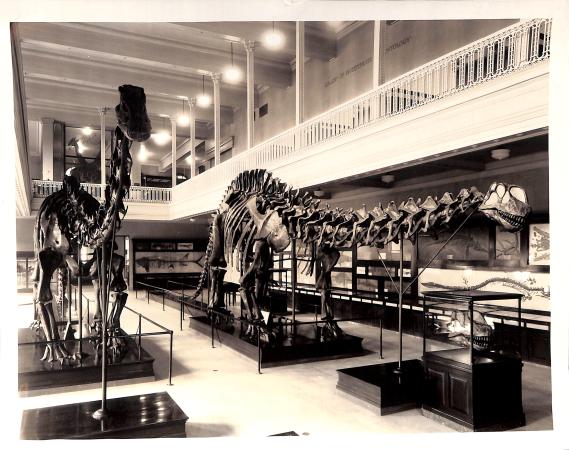The New York Journal and Advertiser of the 11th of December 1898 had an article on page 29; “Most Colossal Animal Ever on Earth Just Found Out West”. It announced the discovery of a “gigantic brontosaur” in Wyoming by Mr. William H. Reed. Andrew Carnegie, the steel magnate, decided to secure the find for the new Museum of Natural History at the Carnegie Institute in Pittsburg. The Director of the Museum, Dr. William J. Holland, was ordered by Andrew Carnegie to purchase the find for the museum and contacted the discoverer.
An excavation team was assembled consisting of J.L. Wortman, A.S. Coggeshall and W.H. Reed and got to work. While the original find turned out to be only part of a huge thigh bone, with funds from the steel magnate a lengthy search and excavation was undertaken which recovered bones and fragments from several specimens of diplodocus.
Responsible for the scientific investigation and preparation for the display was J.B. Hatcher. The bones and fragments were used to create a single “Diplodocus” for the Museum of Natural History. So Diplodocus Carnegii is not a single specimen; it is a combination from several specimens which were put together to create a single Diplodocus. While “Diplodocus Carnegii” was being investigated and pieced together, Andrew Carnegie had a drawing made. This drawing turned out to be an important catalyst for future events.
Duplication and Dispersion
One day in October 1902, King Edward VII paid a surprise visit to Skibo Castle. The King, who apparently wanted to see how Andrew Carnegie managed to incorporate the most modern of technologies in his castle, apparently saw the picture and made either (here stories tend to be in conflict) an offhand request or a special request for a Diplodocus for the British Museum.
Andrew Carnegie, always on the lookout to improve his standing worldwide, immediately went to work. A second original would be hard to find and recreate so the second best option was chosen; a duplicate. Molds were made of the bones and a plaster duplicate was made of every bone. First under the supervision of J.B. Hatcher and, after his untimely death, Dr. Holland.
The duplicate was presented to the trustees of the British Museum on the 12th of May 1905. A distinguished company was assembled and Andrew Carnegie and Dr. Holland presented the Diplodocus in the Hall of Reptiles, the Hall of Palaeontology being greatly crowded. In 1979, the skeleton cast was moved to the Hintze Hall of the Natural History Museum (The Natural History Museum and the British Museum legally separated in 1963) and will go on tour in 2018. The donation of the Diplodocus did not go unnoticed. Several other requests were made by for a plaster cast of Diplodocus Carnegii. Andrew Carnegie generously arranged for more casts to be made from the molds. There were so many requests for casts “that only the request from the head of the state will be considered.”
Casts were made and sent to museums around the world; Berlin, Bologna. Buenos Aires, St. Petersburg (now in Moscow), Madrid, Mexico City, Munich (never set up, still in storage), Paris, and Vienna. Together with the cast in the British Museum, this was a large program which allowed researchers from all over the world to study the sauropod.
Peace Diplomacy
Diplodocus Carnegii is probably the most copied and accessible large dinosaur in the world. People may wonder; why did Andrew Carnegie donate so many casts and why did he demand requests by heads of state in order to obtain a cast? It was not all vanity and fame. It was also building up useful connections for peace. Andrew Carnegie was, besides a shrewd businessman and philanthropist, also active in the peace movement, paying (among others) for the construction of the Peace Palace. The peace movement had been active for many years and influencing public opinion was much easier than influencing politicians and the national elites. Using his casts as gifts, Andrew Carnegie came into contact with heads of state. Through these personal connections, he promoted peace and the peaceful settlement of disputes through arbitration.
